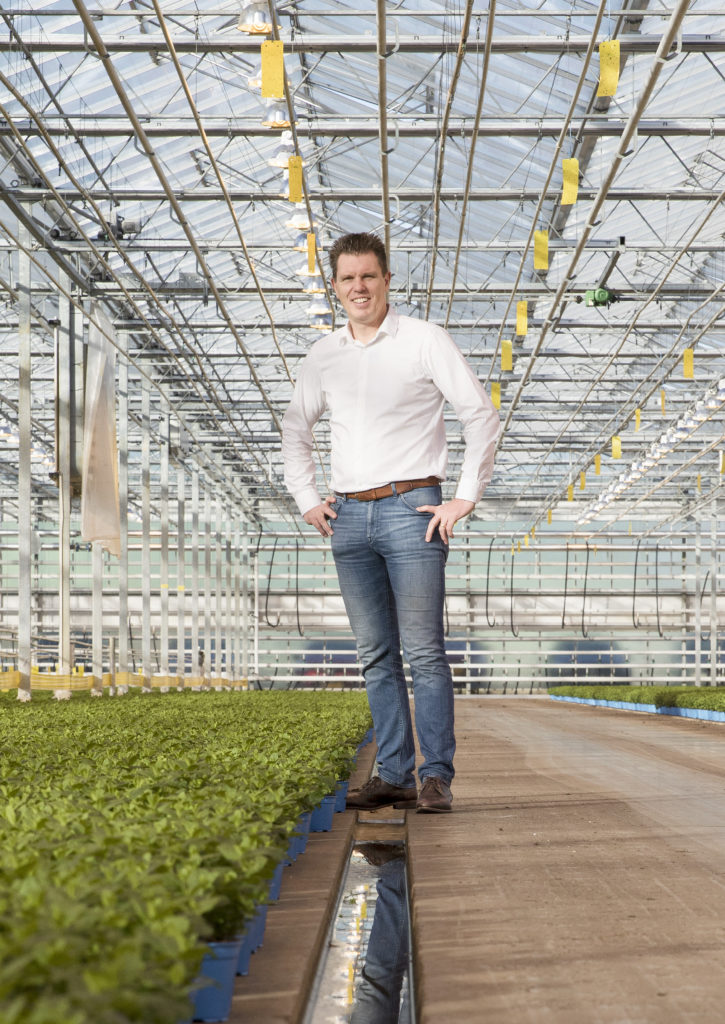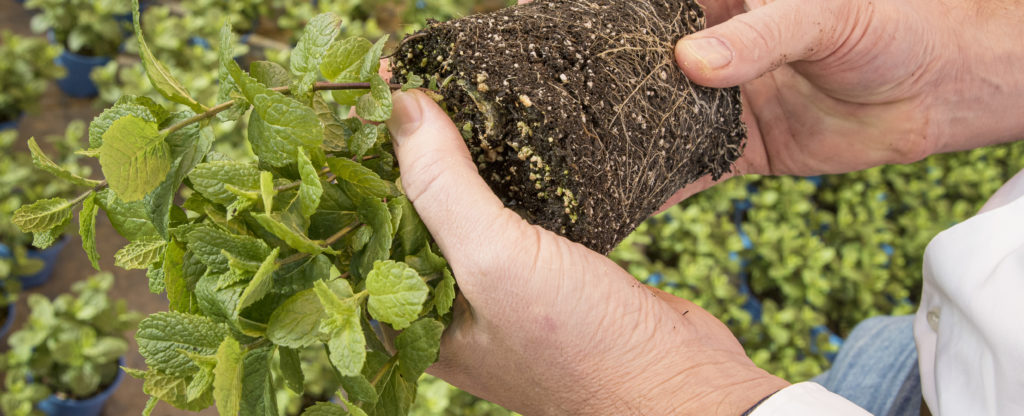Interview Gipmans Planten
Plant resistance is an important topic at Gipmans Planten. Erik Gipmans interprets sustainable cultivation as replacing crop protection products for resilient plants with the ability to ward off pathogens themselves. Substrates are important to him, because they add quality at the start of the chain. ‘The demand for sustainable substrates is currently highly relevant, so that way we can position our products properly on the market’ he believes.
The name Gipmans is firmly embedded in Greenport Venlo. In a year’s time, the plant nursery will celebrate its 50th anniversary. The company enjoys an ideal location from a logistics perspective. Vegetable plants and herbs grown outdoors and under glass find their way to end customers mainly in the Netherlands, Belgium, Germany, Switzerland, Austria and Northern Italy.
Brothers Jos and Erik, and their cousin René Gipmans, form the executive board, together with financial director Li-Ang Yah. Very recently, the company increased in scale again by merging with A. Scheurs in nearby Sevenum. This nursery specialises in cultivating field-grown vegetable plants. Both companies will cooperate intensively on innovation and IT.

Long-term relationships
‘We invest in long-term relationships’, says Erik Gipmans. The company has a large number of permanent employees who have worked at Gipmans for many years, and enjoys a close, loyal relationship with its extensive base of regular suppliers and customers. The relationship with BVB Substrates – Euroveen has a long, stable history. ‘In fact, I can’t recall a time when the potting soil wasn’t supplied by Euroveen in Grubbenvorst. That’s also really convenient in logistic terms as they are literally just around the corner, no more than ten minutes from our company.’ Gipmans gets through 60,000 m3 of potting soil annually. Between mid-December and mid-August, between 20 and 30 trailers drive back and forth daily to supply mixtures for the press pots. There is also a constant stream of organic potting soil for the 10-hectare herb nursery Especia.
Herb nursery
Cultivating herbs started as seasonal activity, a useful way of utilising the space outside the growing season for plants that needed to be grown in heated greenhouses. Now herbs are an indispensable ingredient in every modern recipe. The herb nursery has therefore evolved into an independent branch of the plant nursery. The assortment comprises 16 different kitchen herbs, of which basil takes the largest share, followed by parsley and mint. Erik: ‘We have built up many of the skills required to grow herbs ourselves. For example, mint is not easy to grow. We are starting to master the art now.’ Growing herbs has led to intensive contact with the retail sector. Supermarkets not only place demands on food safety, but also on sustainability. This extends to both the packaging materials and the raw materials, including the potting soil. ‘Those demands are very compelling and important’, explains Erik. ‘We must be able to market products with good sustainability credentials.’
No concessions
Sustainability is a priority at Gipmans. The use of peat products is under scrutiny because of the impact on nature. ‘We have to be brutally honest about it. The amount of raw materials we use every year has immense consequences on vulnerable peat regions’, he continues. ‘So, we have given ourselves the challenge of using potting soil in a better, more responsible way. This has also been communicated with BVB Substrates.’
In concrete terms, Gipmans is running trials with smaller press pots, which effectively reduces the volume by 15%. But it’s no easy task. Smaller pots, with hollow spaces for example, must still enable the same vigour. ‘We absolutely can’t make any concessions on the quality of our final product. In fact, a minor glitch at the start of cultivation can have a significant knock-on effect in further links of the cultivation or wider supply chain.’ This not only applies to vegetable plants, but also to the herbs which have to remain usable for a few weeks after they have been bought by consumers.
Sustainable potting soil
Another route to more sustainable use of potting soil is whether accelerating the recovery and regrowth of peat regions after the raw material has been harvested is possible. Gipmans cannot answer this question, but it clearly falls in the domain of the potting soil company. Replacing peat with another raw material is another option. ‘We are looking for a product with the same properties as black peat. Black peat is still an indispensable ingredient, but it is the least sustainable component in potting soil mixtures’, says Erik. Gipmans and the product brand BVB Substrates have close and intensive contact in the form of trials aimed at improving the composition of blends and developing a new substrate. ‘I expect a breakthrough with a product that can successfully replace a percentage of the black peat in the short term and eventually completely replace it.’
Resistant plants
A subject that particularly concerns Erik is disease control, or plant resistance. The nursery has a special responsibility in this area, he believes. The recent pressure of viruses in vegetable crops is increasing the urgency of this subject. ‘The question is no longer whether we will see outbreaks of certain diseases, but when’, he explains. ‘We are researching integrated, vertical cultivation systems. This is teaching us that plants remain disease-free in controlled systems’, he continues. ‘So, growing using a minimum of crop protection products is already possible in principle.
We also want to discover how to make young plants unattractive to pests, for example aphids. In other words, how we can boost the resistance of our plants.’ Are customers already asking for plants with higher resistance? ‘No, not yet. But we want to anticipate that demand and learn to understand the underlying system. The focus of customers is on the use of pesticides and the levels of residues
left behind on products. I predict that in the future we can eliminate that discussion.’ What he does expect to intensify though, is the debate surrounding the microbiome balance. Attention for food safety scandals, where bacteria were found that cause food infections, is becoming increasingly important. ‘That means we must make every effort to safeguard food safety.’

Julien Boijmans, sustainability manager Kekkilä-BVB:
It is true that peat harvesting has an impact on climate due to the release of greenhouse gasses such as CO2 and methane. However, we minimize the negative climate impact of peat harvesting by not harvesting peat from untouched, pristine or protected bogs. We only harvest on RPP type 3-4 fields. These fields are already drained and degraded for purposes such as agriculture and forestry. The surface of these fields amount to about 40% of the European peatlands. These peatlands are drained, otherwise they can’t be used. When peatlands are drained and degraded they are already emitting CO2 (carbon dioxide) and have been doing so ever since they were drained. These degraded peatlands can be perfectly used for peat production as their rehabilitation afterwards will reduce the emission of CO2 significantly and eventually lead to storing CO2 again.
At Kekkilä-BVB, we are establishing the sustainable peat harvesting and after life concept of which RPP (responsibly produced peat) is an important step. Through this process we minimize the negative impact of peat harvesting and ensure a sustainable after life. This usually consists out of renaturalisation, forestry and agriculture. The type of after life depends on the natural properties of the bog and whether it is owned or rented from a third party.
The sustainability of a growing media or a constituent of a growing media is not just defined by its input but also by its effect on the growth of a crop. Peat is a high quality constituent of growing media which enables high quality growth of crops. Additionally, we have set the target that all of our innovations promote sustainability by 2020. This includes the development of complementary raw materials such as BVB Accretio.